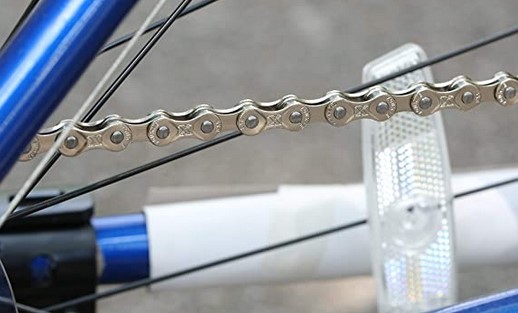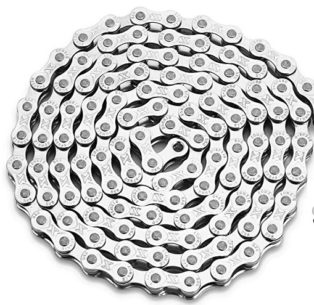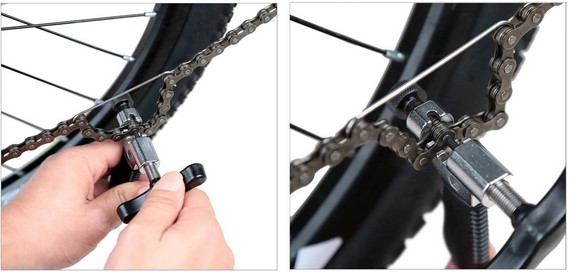Bike chains are some of the unsung heroes of cycling, doing the crucial work of rotating the gears and getting you moving. Therefore, it’s essential to ensure it’s the right size and works perfectly, but when it doesn’t seem to fit perfectly, you’ll likely wonder, is my bike chain too long?
Your bike chain is too long if you can’t keep it tight and shifting gears is too slack. However, find out the precise chain length using the Z method, calculate it, compare a new chain with an old one, lift the chain from the bike chainring, or the largest chainring/largest cog method.
It is vital to know how to check your chain size and shorten a long chain. Keep reading to find to get relevant answers on the topic.

How Do I Know My Bike Chain Size? Is My Bike Chain Too Long?
As mentioned above, you can check your bike chain’s length and determine if it’s sagging through the Z method, the largest cog and largest chainring method, use the equation, or simply compare a new chain with your old one. For your safety, do it while the bike is immobile.
The ways will also help you determine if your bike chain is likely worn out/ stretched and doesn’t fit your bicycle anymore. Well, let’s go through each method in-depth, including the steps to follow.
1. Compare New Chain With An Old Chain
When replacing your old bike chain with a new one, you can use the old one to resize the new chain. Compare the two chains and cut the new one to the point where it matches the old one.
Make sure the inner and outer plates match when aligning the chain ends to get the precise length. This method only works if the old chain’s length is accurate.
2. Largest Cog And Largest Chain Ring Method
Here’s what to do:
- Move the front derailleur to the biggest chainring, then the rear derailleur to the tiniest chainring.
- Fold the chain around the big rear cog.
- Pass the end of the chain via the compartment of the front derailleur to the front-most biggest chainring, then hold it closest to a 5 o’clock angle as you can.
- If your chain operates with a master link, install just half the master link to account for the other half an inch the master link offers. Once you install the plate, the remaining process is similar to joining rive chains.
- Pull the chain snug’s lower section and join it with the front chainring.
- For accurate sizing, ensure the chain is completely engaged to the biggest rear cog. Therefore, bypass the rear derailleur altogether, and additional length will be included in the account later.
- Locate the adjacent rivet to where the two chain ends can be joined.
- Join the chain by linking the inner plates to the outer plates (The closest rivet to where you can join the chain serves as the reference rivet)
- Add two extra rivets from the rivet to get the chain’s cutting point.
- Cut the bicycle chain using a chain tool.
Sometimes, an outer plate coincides with another outer plate when your pull the lower section snug. You don’t get a reference point from this because you cannot join the bike chain here.
To get a reference point in this situation, add a rivet, then add two more rivets to get the cutting point.

3. Z Shape Method
While the bike is in parking, check for extra chain by shifting to the large-large combination. Do this by pulling a chain link over itself, making nearly a Z shape.
If a whole full link can fold over another link, your chain has an extra link, thus making it too long.
If you can keep extending the Z shape using multiple links, continue until the bike’s rear derailleur no longer counts links. This provides an idea of the number of links giving the chain the additional length.
4. Use The Equation
You can determine the bike chain’s length through the derailleur chains’ industrial equation. The length of bicycle chains is in the form of whole integers because they comprise inner and outer plates, ruling out fractions.
So, to measure the chain length, do this:
- Count the largest front and rear sprockets’ teeth. Check the sprockets because the numbers could be printed on them.
- Calculate the space between the midpoint and rear axle of the crank bolt.
- The distances should be to the nearest 1/8 inches.
- Convert the number into decimals.
- Use the equations which is L= 2 (C) + (F/4 + r/4 +1)
L= the chain’s length in inches.
C= the chainstay length (inches) for the steps described above.
F= the teeth number on the largest front sprocket.
R= the teeth number on the largest rear sprocket.
Do I Need To Shorten My Bike Chain?
Shorten your bike chain if the distance separating 12 links is below 12.125 inches but above 12 inches. However, do not rush into shortening your bike chain because if the distance is over 12.125 inches, it’s time to replace your chain.
It’s also vital to know what made your bike chain too long because it happens due to different reasons. For instance, sometimes, when you buy and fix the chain yourself, you may find that it’s too long and needs to be resized, and other times, the bike shop overestimates a new chain’s length when installing it.
The common reason is stretching, which occurs from wear after using the chain for a while. In such a case, you’ll need to replace it because once the chain goes beyond the recommended chain stretch recommended limit, it is time to get a total replacement.
If you are shopping for a chain replacement, check out Zonkie 6/7/8 Speed Bike Chain (View on Amazon)with a strong rally, smooth lubrication, 116 links, and impeccably withstands corrosion and rust.
Determine if you need to shorten or replace the chain by counting 12 links, then measure the distance between the first and the 12th link. The ideal length is 12 inches (30.48cm).
You should replace your chain if the distance is over 12 1/8 inches (30.80cm) because it indicates that the pins are getting worn out, lengthening the chain in the process. If it’s less than 12 1/8-inches, you can shorten the chain to make it safer and more effective.

How Do You Shorten a Chain Length?
Once you ascertain that you need to reduce your chain length, remove and clean it, then shorten it by following the steps below.
Shorten The Bike Chain
- Determine the number of links you’ll need to remove to correct the length. Take off few links in the beginning because it’s easier to remove one or two more than putting back several links.
- Clamp the chain’s following link. Begin at the ends attached to the master link or any link for a chain without a master link. Use a clamping mechanism or vise to secure the link.
- `Push the pin but not all the way out and line up the punch on the chain tool over the pin of the link. Turn the tool’s handles slowly clockwise and stop once the pin is past the outer plate but still connected to the link.
- Make sure the pin doesn’t go entirely out of the link because replacing it may not be possible in most cases. Therefore, it’s crucial to have a chain tool. If you don’t readily have one, the portable, durable, universal, well-designed Oumers Universal Bike Chain Tool (View on Amazon) is an excellent choice.
- Do the same for the second pin, take apart the link, and do the same to the other pin in this link, pushing it out to a distance that can let you hoist one of the outer plates.
- Remove extra links to shorten the bike chain. Ensure you only remove the links you need to make the chain function, leaving the pins attached partially like before.
Reassemble The Bike Chain
- It’s time to reassemble, so put the master link onto the chain’s both ends. You’ll likely need a screwdriver or pliers to get this done.
- Push the two links together till the pins click into position in the inner click.
- Use the chain tool to re-join the chains by placing the two links back to the outer slot of the chain tool, making sure the pins face towards the pin of the chain tool.
- Rotate the handle in an anticlockwise motion, and the pins of the chain tool will begin pushing the pins through the link. Continue until you a tiny part of the link coming out of the other side.
- You should also see the chain pin sticking out on the link’s both sides.
- Reposition the pin if necessary and lubricate the chain once you are done.

FAQs
1. How Long Should A Chain Be On A Bike?
The ideal length of your bike chain depends on your bike. An internally geared/single-speed bike uses either 3/32 inches or 1/8 inches, while a bike with a derailleur requires an 11/128 inches or 3/32 inches chain.
On the other hand, a tricycle or heavy-duty cargo bicycle uses a 5/32 inches chain. To ensure your bike chain is the right fit, put it around the largest rear sprocket and the biggest front chainring, then add two more rivets.
2. Why Is My Bike Chain Too Long?
Your bike chain is too long because it wore off, causing it to stretch in the process, or the rear and front derailleurs are misaligned, which makes gear shifting noisy or even makes the chain detach from the cogs.
3. How Do I Know If My Mountain Bike Chain Is Too Long?
Do a simple examination of your mountain bicycle by shifting the bike chain to the largest cassette cog and the big chainring. Next, push forward on the derailleur cage’s end to determine how much it can move forward.
If the movement is minimal, your bike chain is good, but the bike chain is sagging if the forward motion is significant.
4. When Should I Shorten My Bike Chain?
Shorten your bike chain if the distance between 12 chain links is less than 12 1/8 inches but more than 12 inches (the perfect length). Doing so will better your bike’s performance and let you enjoy bike riding more.
In Conclusion, Is My Bike Chain Too Long?
Now that you have the methods to measure your bike chain length, you can determine how much you need to shorten your chain when it’s too long.
The job doesn’t require special skills or a pro to do these repairs, just get the right tools and follow the instructions.
In addition, be mindful of your bicycle to realize when it’s time to replace your chain.
Also Read:
